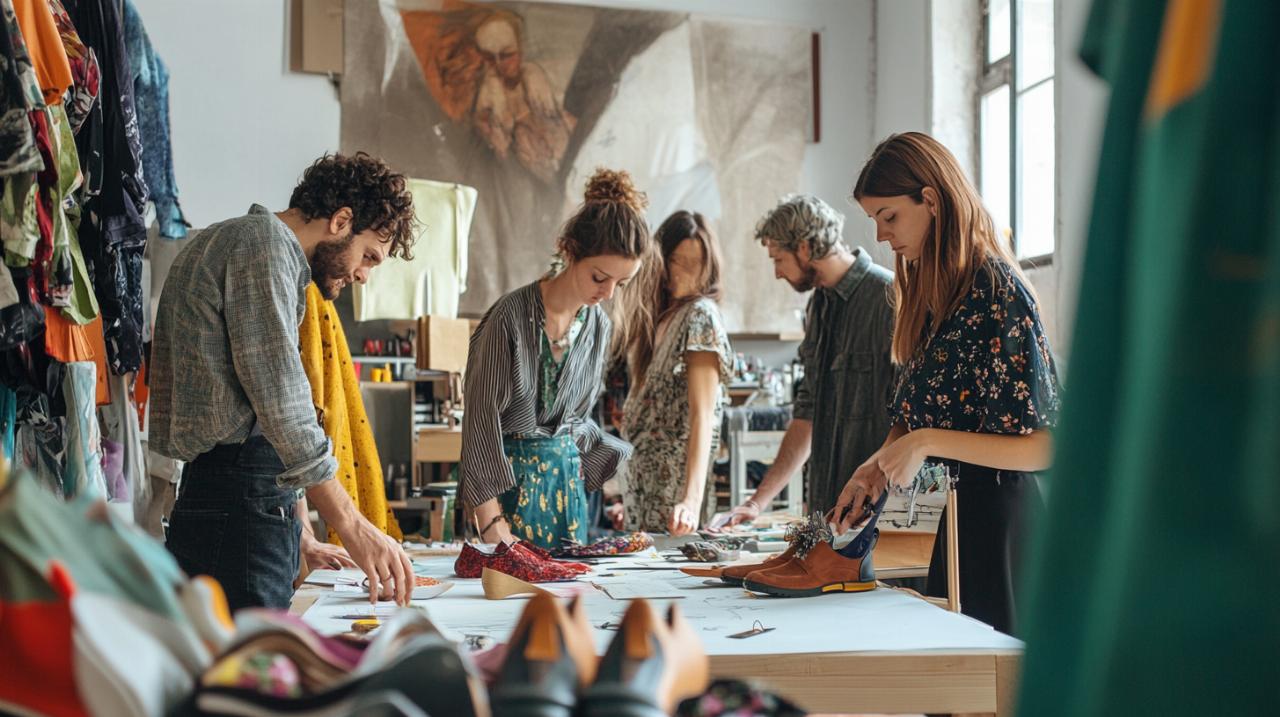Creating footwear from scratch might seem like a distant dream reserved for cobblers and artisans tucked away in workshops, yet with a bit of patience and the right approach, anyone can craft their own pair of shoes at home. This process combines creativity with practical skill, allowing you to design something that truly reflects your personal style whilst ensuring a perfect fit. Whether you fancy a pair of sleek leather brogues or casual canvas trainers, embarking on this journey opens up a world where fashion meets function in the most satisfying way.
Planning and designing your bespoke footwear
Sketching your vision and choosing a style
Before diving into the physical work, it is essential to establish a clear vision of what you want to create your own custom shoes tutorial. Take inspiration from the world around you, whether that is contemporary fashion trends, the natural environment, or even classic art. Consider the intended purpose of your shoes: are they for everyday casual wear, something more formal, or perhaps for a specific sport or activity? Once you have a sense of direction, put pen to paper and sketch your design. This does not need to be a masterpiece of technical drawing, but it should capture the silhouette, the key features, and any distinctive details you wish to incorporate. This step is where your imagination takes centre stage, so do not hold back on exploring different shapes and embellishments.
Selecting colours and materials for your design
After settling on a style, the next decision involves choosing the materials and colours that will bring your vision to life. For the uppers, you might opt for leather, which offers durability and a timeless aesthetic, or perhaps canvas and synthetic fabrics for a lighter, more breathable option. Suede can also add a touch of elegance and texture. When it comes to soles, rubber provides excellent grip and resilience, whilst leather soles offer a classic feel, and EVA foam delivers cushioning for comfort. Think about the colour palette carefully, as this will define the overall look of your shoes. Neutral tones work well for versatile, everyday footwear, whereas bold hues or patterns can make a striking statement. Remember to consider how the materials will work together both visually and practically, ensuring that your choices complement the design you have sketched.
Gathering essential materials and tools
Sourcing quality leather, suede, or canvas
Once your design is finalised, it is time to gather the materials that will form the foundation of your shoes. Quality matters here, as the longevity and appearance of your footwear depend on the fabrics and leathers you select. Visit local craft shops, fabric suppliers, or specialist leatherworkers to find the right materials. If you are working with leather, look for hides that are supple yet sturdy, with a consistent texture. Canvas is an excellent choice for those who prefer to work with fabric, as it accepts acrylic paint well and is relatively easy to handle. Suede can be a bit trickier to work with, but it rewards you with a luxurious finish. Do not forget to pick up any additional fabrics for the inner lining, which will provide comfort against your skin and help the shoe maintain its shape.
Finding the right lasts, soles, and hardware
A crucial component in shoemaking is the last, which is a foot-shaped mould that you will build your shoe around. You can either purchase a ready-made last from a supplier or take the more personalised route of casting your own foot using alginate and a casting material. This latter method ensures an exact fit, which is invaluable for comfort and support. In addition to the last, you will need to source insoles, midsoles, and outsoles. Cork sheets or shoe leather work well for insoles, whilst rubber or EVA foam are popular choices for the outer sole. Hardware such as eyelets, laces, and any decorative studs or buckles should also be collected at this stage. Tools like scissors, a retractable utility knife, an awl for puncturing holes, pliers, needles, thread, and a cutting mat are indispensable. Strong adhesive designed for footwear, often referred to as shoe glue, will be needed to bond the various components securely.
Cutting and preparing your pattern pieces
Tracing your design onto chosen materials
With all your materials and tools at hand, the next phase involves translating your design into tangible pattern pieces. Begin by taking accurate measurements of your foot, tracing its outline on paper to capture both length and width. Decide whether you prefer a snug fit or something a little looser, as this will influence the dimensions of your pattern. Draw out the individual components of the shoe, such as the toe cap, vamp, quarters, and heel counter, based on your measurements and the design you have sketched. If you are using a last, cover it in masking tape and draw your pattern directly onto the tape, then carefully remove and flatten these pieces to create templates. Label each pattern piece clearly to avoid confusion during assembly. Once your patterns are ready, place them onto your chosen material, whether that is leather, canvas, or suede, and trace around them with a marker. Precision at this stage is vital, as any inaccuracies will affect the final fit and appearance of your shoes.
Precision cutting techniques for clean edges
Cutting the material requires a steady hand and sharp tools to achieve clean, professional-looking edges. Use a retractable utility knife or fabric scissors, depending on the material you are working with. A cutting mat underneath will protect your work surface and help guide your cuts. Take your time, following the traced lines carefully and ensuring that each piece is cut smoothly without jagged edges. For leather, a sharp knife works best, allowing you to slice through the material in one confident motion. Canvas and fabric can be cut with scissors, but make sure they are sharp enough to avoid fraying. Once all the pieces are cut, lay them out in order so you can visualise how they will come together. This organisation will streamline the assembly process and help you spot any pieces that may need adjustments before you begin stitching.
Stitching and assembling the shoe upper
Creating strong seams that will last
Now comes the satisfying task of stitching your pattern pieces together to form the upper part of the shoe. Strong seams are essential, as they will endure the stress of walking and flexing. Thread your needle with a durable thread, doubling it over for extra strength if necessary. An awl can be used to pre-punch holes along the seam lines, making it easier to pass the needle through thicker materials like leather. When sewing, use a backstitch or saddle stitch technique, both of which provide excellent durability. Take care to keep your stitches even and consistent, as this not only strengthens the seam but also contributes to the overall aesthetic. If you are working with multiple layers of fabric or leather, ensure they are aligned properly before you begin stitching. Once the main pieces are sewn together, attach the outer fabric to the inner lining, sandwiching any additional layers such as padding or reinforcement in between. This is the stage where the shoe starts to take on its three-dimensional form, and you can begin to see your design come to life.
Techniques for pulling the upper over the last
After assembling the upper, the next challenge is to shape it over the last. This process is crucial for giving the shoe its final form and ensuring a comfortable fit. Begin by placing the last inside the upper, adjusting the fabric or leather so that it sits evenly over the mould. Using small tacks or a strong adhesive, start securing the upper to the bottom of the last, working your way around the perimeter. Pull the material taut to eliminate any wrinkles or excess fabric, but be careful not to stretch it so much that it distorts the design. This step requires patience and a bit of trial and error, as different materials respond differently to tension. Once the upper is securely attached to the last, allow any glue to dry completely before proceeding. This shaping process is what transforms flat pieces of material into a recognisable shoe, and it is one of the most rewarding moments in the entire project.
Attaching soles and finishing touches
Methods for securing the sole properly
With the upper now shaped and secured to the last, it is time to attach the sole, which provides the foundation and durability for your shoes. The insole is the first layer, and if you are using cork or leather, you may want to shape it by soaking it in water and then tying it to the last to mould it to the contours of the foot. Once dried, pare down any excess material so that it fits snugly. The midsole, if you are including one, is added next, followed by the outsole. Apply a generous layer of shoe glue to both the bottom of the upper and the sole, then press them together firmly, ensuring that they are aligned correctly. Use clamps or heavy objects to hold the sole in place while the adhesive cures, which can take several hours or even overnight. For added security, you can also stitch the sole to the upper using a curved needle and strong thread, though this requires some practice to master. If you want to add a heel or treads for extra grip, now is the time to attach them, using the same gluing and clamping technique.

Adding eyelets, laces, and personal flourishes
The final stage of construction involves adding the details that make your shoes functional and uniquely yours. If your design includes laces, you will need to install eyelets along the edges of the upper. Mark the positions for the eyelets carefully, ensuring they are evenly spaced and aligned. Use an eyelet puncher to create holes, then insert the eyelets and secure them with the appropriate setting tool or pliers. Thread your laces through the eyelets, experimenting with different lacing patterns to find one that suits your style. This is also the moment to add any personal flourishes, such as decorative stitching, embossed patterns, or painted designs. If you are working with leather, you might want to apply a polish or sealant to protect the surface and give it a finished look. For canvas shoes, consider using stencils or an airbrush to add intricate patterns or logos. Thin layers of acrylic paint work well on canvas, and it is important to let each coat dry thoroughly before adding the next. Once all the decorative elements are in place, apply a protective varnish or sealant to shield your work from moisture and wear. A matte finish offers a subtle, understated look, whilst a glossy finish can make colours pop and give the shoes a polished appearance. Allow the sealant to cure fully, which usually takes around twenty-four hours, before wearing your new shoes. With the eyelets installed, laces threaded, and all finishing touches complete, you now have a pair of bespoke shoes that are entirely your own creation. The sense of accomplishment that comes from wearing something you have made from scratch is truly unparalleled, and you can take pride in knowing that no one else will have a pair quite like yours.







